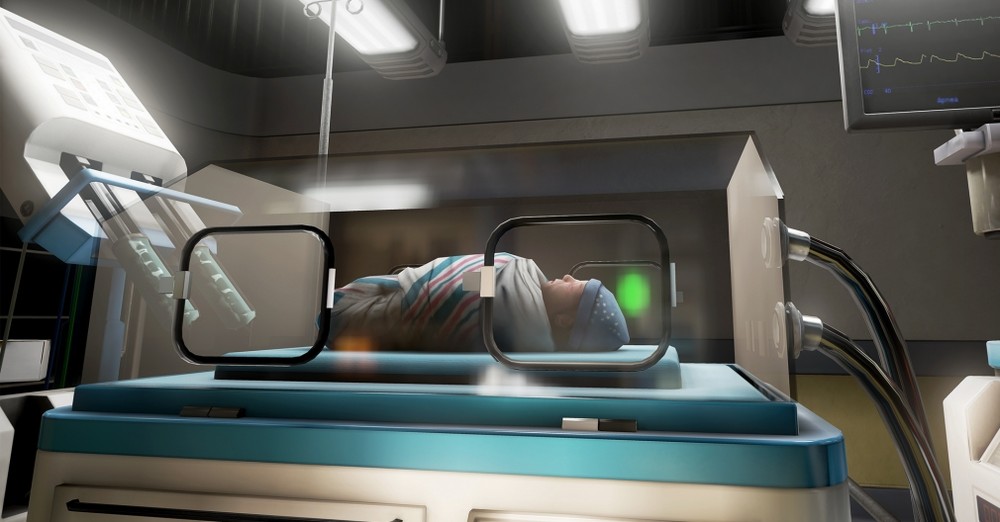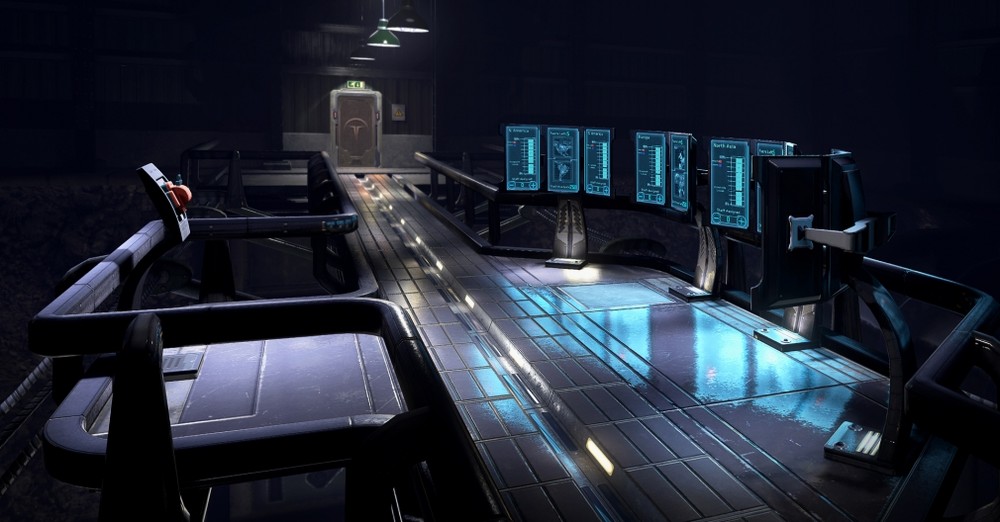When The Assembly released on the Oculus Rift back in August it was already pushing the limits of VR tech on powerful PC’s, so I was surprised they would even attempt to port the game to the woefully under-powered PSVR, but they did and the results are anything but pleasing. Read on if you must, but the short take on this review is that you definitely need to skip this game on PSVR at the risk of vomiting, throwing your headset in anger, or both.
The Assembly, the latest games from nDreams, is being called “The Perfect Intro to VR”, which when translated means that in this first-person adventure, you still use the left stick to move and your head is now your right stick and environmental interaction is nothing more than point-n-click. But despite the rather poor implementation of VR, both in interaction and especially the abysmal graphics, there is still an interesting game lurking behind those giant steel doors of that underground mountain complex. If only I knew the pass-phrase…
The game starts off with a few flashbacks as you inhabit the body of Dr. Stone, the first of two playable characters in The Assembly. She has recently lost her mother during a failed scientific experiment where mom was being used as a willing test subject to cure a virus. Stone was charged with murder but The Assembly has snatched her up and taken her to their mountain research facility where they put her through all sorts of weird tests (mini-games) like navigating mazes and solving dinner party murder mysteries – don’t ask.
Throughout the game you will alternate between Stone and another doctor, Cal Pearson, who is already working in the labs. This is where the more adventuresome parts of the game happen as you explore offices and labs, open every drawer and cabinet, read every email, and examine every object that isn’t nailed down. I thought it was interesting that they separated the exploration from the puzzle-solving by making each sub-genre character specific, and by mixing it up you never get too burned out with either facet of the game. The puzzles themselves aren’t terribly difficult, and even novices can power through them given enough time.
nDreams has essentially taken a standard adventure game and placed it within a 3D modeled world, yet they are fully aware of the dangers of doing so as evident by the numerous options in the menu to make the experience comfortable for the widest range of gamers. Personally, I chose the smooth turning and movement, which is most likely to make you sick, but for those with weaker constitutions you can switch over to snap turns and teleport movement. Sadly, it’s not the movement that will make you sick in this game.
The overall design of the game and puzzles seems almost counterintuitive at times. There are dozens of emails to read but only a few are relevant to the actual game. Even worse, there are hundreds of drawers, file cabinets, and lockers, and 99.9% of them are empty, but you had still better open every last one of them because you can be sure the one you skip has a mission-critical item in it. At least things like pass codes and such are noted and can be called up when needed.
There are moments of pure genius in the game. Early on one of Dr. Stone’s tests was to identify two suspects in the killing of a scientist at the recreation of a dinner party murder. You get to listen to recorded statements from each suspect and investigate these little cubicles pertinent to each of their lives for clues before choosing the two people you think did it. Even though this entire “test” seemed out of place with the rest of the game I was completely immersed; more so than any Sherlock Holmes or C.S.I. game I had played in the past.
The Assembly is arguably a bit on the short side, even for a VR title. You can probably finish the game in 4-5 hours and experiencing both endings is merely a matter of loading your save game and making the “other choice” at a very binary plot branch moment. It was a nice mix of adventure and puzzle-solving with a cool story that will engage players assuming they can come to grips with the terrible graphics.
The game has a great visual design although the clarity suffers from the VR screen door effect, plus some new type of distortion that makes everything look like you are viewing it through water. The graphics literally ripple and the aliasing is so horrible that even standing still you can watch the jaggies on every edge of every object slowly stair step down the line. The game is so swimmy and blurry that it’s even hard to read the text for the countless emails and logs you need to scan during the game. It’s so bad I am basing most of this review on my Oculus experience. Playing on the PSVR I started getting sick in the opening office main menu and by the time I had navigated Dr. Stone to her first puzzle challenge I had to stop playing at the risk of vomiting. Personally, the game is unplayable for me, which is sad because it’s a really good game – just not for PSVR.
The Assembly has some excellent audio that you can enjoy with or without headphones, although since this is a seated game you can use any existing surround sound setup as well. The music and sound effects are spot on with this sci-fi, mystery, thriller narrative, and the voice acting is outstanding and there is a lot of it, both actual and internal monologs.
In their attempt to cater to the widest audience possible nDreams has essentially diluted the gameplay down to the point where it is merely a basic adventure game, and your expensive VR headset is nothing more than some 3D glasses with head-tracking. Sadly, the underpowered PSVR can’t possibly begin to keep up with the visual demands of this title and the end result is a total disaster that no one should subject themselves to. The only positive spin I can put on this is that if you have a Rift or Vive then definitely check out the game on one of those systems.















